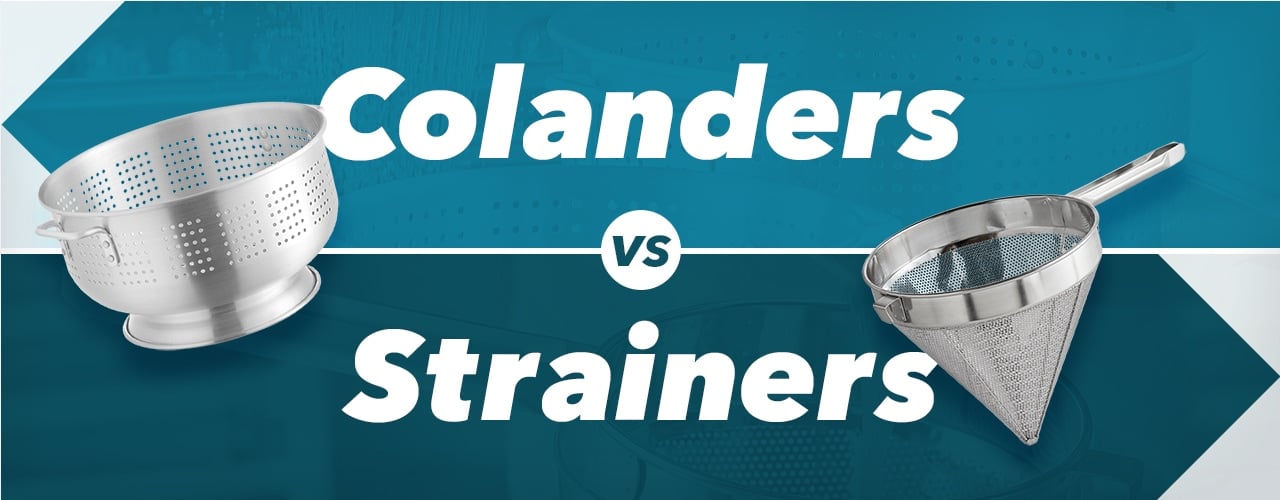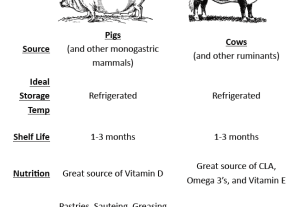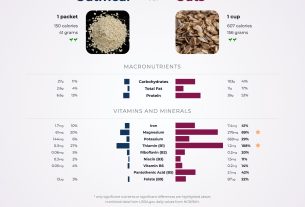In the world of kitchen gadgets, there are two unsung heroes that often get mistaken for one another – colanders and strainers.
While their purpose may seem seemingly simple – draining and rinsing food – their subtle differences make all the difference.
Think of them as culinary superheroes, each with their own unique powers designed to conquer specific culinary challenges.
So, get ready to dive into the wonderful world of colanders and strainers as we explore the vast array of options and the vital roles they play in creating culinary marvels.
strainer vs colander
In summary, a colander and a strainer are different tools with specific uses.
A colander, made of inflexible material with larger holes, is best for washing produce, draining beans, or draining larger pasta shapes.
On the other hand, a strainer, made of fine mesh with tiny openings, is better for draining or rinsing things with smaller pieces, such as orzo pasta or small legumes.
Strainers are also commonly used for draining pasta or vegetables and for straining sauces.
Specialized types of strainers, like the chinois and strainer basket, have their own unique uses.
Both types of strainers can be easily found in restaurant or kitchen supply stores.
Key Points:
- A colander is made of inflexible material with larger holes and is best for washing produce, draining beans, or draining larger pasta shapes
- A strainer is made of fine mesh with tiny openings and is better for draining or rinsing things with smaller pieces, such as orzo pasta or small legumes
- Strainers are commonly used for draining pasta or vegetables and for straining sauces
- Specialized types of strainers, like the chinois and strainer basket, have their own unique uses
- Both types of strainers can be easily found in restaurant or kitchen supply stores
- A colander and a strainer are different tools with specific uses
strainer vs colander – Watch Video
💡
Pro Tips:
1. The strainer and the colander may seem similar, but they actually serve different purposes. A strainer is designed to separate liquids from solids, while a colander is used to drain liquids from larger solid ingredients, such as pasta or vegetables.
2. The two terms, “strainer” and “colander,” have different etymological origins. The word “strainer” derives from the Old English word “streynan,” meaning “to sift or strain,” while “colander” comes from the Latin word “colum,” meaning “a sieve or strainer.”
3. The first documented use of a colander dates back to ancient Greece, where it was made from woven reeds or similar materials. Essentially, it was a primitive version of the modern-day colander we use today.
4. Strainers and colanders have been essential tools in kitchens for centuries, but before their invention, people used natural materials for similar purposes. For example, early cooking enthusiasts used large seashells or perforated leaves to strain liquids from solids.
5. Strainers and colanders have inspired various cultural references and idiomatic expressions. The concept of “straining” or “sifting” the truth can be traced back to the use of strainers in the kitchen. Additionally, the proverb “Don’t wash your dirty laundry in public” may have its roots in the practice of draining water from clothes using a colander-like device.
Colanders: What Are They And How Are They Different From Strainers?
Colanders and strainers are kitchen tools used for draining liquids from food items. However, there are distinct differences between them.
A colander is typically made of inflexible materials such as metal, plastic, or ceramic. It features a bowl-shaped design with larger holes drilled all around. This design allows for quick and efficient draining of liquids from foods such as pasta or vegetables.
On the other hand, a strainer is usually made of fine mesh with tiny openings. It is asymmetrical, with a lip on one side and a handle on the other. This design allows for more precise straining, making it ideal for removing small particles from liquids such as seeds or pulp from juice.
In summary:
- A colander is made of inflexible materials with larger holes for quick draining.
- A strainer is made of fine mesh with smaller openings for precise straining.
Note: Each tool has its own unique characteristics and purposes, making them essential in the kitchen for various cooking and food preparation tasks.
Characteristics Of Colanders: Material And Hole Size
Colanders are commonly made of stainless steel, plastic, or ceramic, depending on personal preference and specific needs. The holes in a colander are intentionally larger to facilitate the quick draining of liquids. The larger holes allow water to flow freely while keeping the food intact. This makes colanders ideal for washing produce, draining beans, or straining larger pasta shapes. Colanders are known for their sturdy construction and ability to withstand the weight of the food being drained without losing their shape.
Common Uses For Colanders: Washing Produce And Draining Pasta
Colanders are versatile tools that find their application in various kitchen tasks. One of the most common uses for a colander is washing produce. Whether it’s fresh fruits or vegetables, a colander allows you to rinse them thoroughly and remove any dirt or debris.
Additionally, colanders are great for draining pasta after it is cooked to the desired tenderness. The larger holes of the colander ensure that the water is efficiently drained while keeping the pasta in place.
Colanders are also useful for draining larger legumes like beans, ensuring that excess liquid is removed without losing any of the beans themselves.
Types Of Colanders: Stainless Steel Vs Decorative Options
Colanders are available in various types, catering to specific needs and preferences. In professional kitchens, large stainless steel colanders are widely used due to their durability and ability to withstand heavy usage. These colanders are designed to handle high temperatures and are easy to clean.
Alternatively, for occasional use, there are smaller decorative colanders made of plastic or ceramic. These colanders not only serve their purpose but also add a touch of style to the kitchen.
Ultimately, the choice of colander depends on factors such as frequency of use and personal preferences.
Strainers: An Overview Of Their Construction And Design
Strainers are distinguished from colanders by their fine mesh construction and asymmetrical design. The fine mesh contains tiny openings that effectively filter liquids while still retaining smaller food particles. In contrast to colanders, strainers are typically made of thinner and more flexible material, enabling them to adapt to the shape of the food being strained.
Key features of strainers include a lip on one side and a handle on the other. This design facilitates convenient handling and ensures a controlled pouring process.
To summarize:
- Strainers have a fine mesh construction and asymmetrical design.
- The mesh effectively filters liquids while retaining smaller food particles.
- Strainers are made of thinner and more flexible material than colanders.
- They feature a lip and handle for easy handling and pouring.
“Strainers are an essential kitchen tool for separating liquids and solids, allowing for efficient food preparation and cooking.”
The Flexibility And Fine Holes Of Strainers
The flexibility and fine holes of strainers make them the perfect tool for draining or rinsing food items with smaller pieces.
For example, when cooking orzo pasta or small legumes like lentils, strainers ensure that no pieces are lost while effectively removing excess liquid. The fine mesh prevents these smaller food items from slipping through, ensuring that only the liquid passes through the strainer.
Furthermore, strainers are excellent tools for sieving the foam of stock during the cooking process, resulting in a cleaner and more refined final product.
- Strainers are flexible and have fine holes, making them ideal for draining or rinsing food items with smaller pieces.
- They prevent the loss of food pieces while effectively removing excess liquid.
- The fine mesh of the strainer prevents smaller food items from slipping through, allowing only the liquid to pass through.
- Strainers are also useful for sieving the foam of stock, resulting in a cleaner and more refined final product.
“The flexibility and fine holes of strainers make them the perfect tool for draining or rinsing food items with smaller pieces.”
Ideal Uses For Strainers: Draining Small Pieces And Sieving Stock
Strainers excel in specific tasks that require the removal of smaller food pieces or the separation of liquids and solids. Their design, with fine holes and flexible mesh, makes them ideal for draining or rinsing small food pieces like grains, pastas, and even vegetables. Additionally, strainers are particularly useful for sieving the foam that forms while making stock. The fine mesh of the strainer effectively captures any impurities or unwanted particles, resulting in a clearer and more flavorful stock.
- Strainers are designed with fine holes and flexible mesh, making them ideal for draining or rinsing small food pieces.
- They are particularly useful for sieving foam while making stock.
- The fine mesh effectively captures any impurities or unwanted particles.
- Using a strainer results in a clearer and more flavorful stock.
“Strainers excel in specific tasks that require the removal of smaller food pieces or the separation of liquids and solids.”
Exploring Different Types Of Strainers And Their Purposes
There is a wide range of strainers available to suit different culinary needs. One such type is the chinois, which has a conical shape and is often used for straining thicker mixtures such as sauces or purees. The conical shape of the chinois enables it to effectively strain out any lumps or larger food particles, resulting in a smoother consistency.
Another type of strainer is the strainer basket, which is cylindrical in shape and is perfect for boiling pasta or blanching vegetables. The strainer basket can be directly placed into the boiling water, eliminating the need for pouring hot water and minimizing the risk of accidents or burns.
- Chinois: conical shape, ideal for straining sauces or purees, removes lumps and larger particles for smoother consistency.
- Strainer basket: cylindrical shape, perfect for boiling pasta or blanching vegetables, can be placed directly into boiling water for safety.
Tip: Use a chinois for thicker mixtures like sauces and purees, and a strainer basket for boiling pasta or blanching vegetables.
Common Applications For Strainers: Draining Pasta, Vegetables, And Sauces
Strainers in the Kitchen
Strainers play a vital role in a variety of kitchen tasks that involve draining or separating liquids. They are commonly used when straining small food pieces such as pasta or vegetables, but their usefulness extends beyond that.
A key application of strainers is in straining sauces. Whether it’s a homemade tomato sauce or a velvety gravy, a strainer ensures that the desired liquid consistency is achieved by removing any unwanted lumps or solid particles. This results in a smoother and more refined sauce, enhancing the overall taste and texture of dishes.
In addition to sauce straining, strainers also come in handy when preparing soups or stews. They enable easy removal of herbs or whole spices, which not only enhances the overall flavor but also improves the presentation of the dish.
To summarize, strainers are versatile tools in the kitchen that help achieve desired liquid consistency, remove unwanted particles, and enhance the flavor and presentation of various dishes.
- Some common uses of strainers include:
- Draining small food pieces like pasta or vegetables
- Straining sauces to achieve a smooth consistency
- Removing herbs or whole spices from soups or stews
“Strainers are like unsung heroes in the kitchen – they quietly enhance the quality of our dishes without much attention.”
Specialized Strainers: Chinois And Strainer Baskets
In addition to the common types of strainers, there are specialized options available that cater to specific culinary needs. The chinois, mentioned earlier, is perfect for straining thicker mixtures and achieving silky smooth textures. Its conical shape and fine mesh make it an essential tool in professional kitchens and for serious home cooks. Another specialized strainer is the strainer basket, which proves to be very useful when cooking pasta or blanching vegetables. Its cylindrical shape fits perfectly into pots, allowing for draining without the need to pour hot water, minimizing splashes and ensuring safety.
Understanding the differences between colanders and strainers is important in making an informed choice for your kitchen needs. Colanders, with their inflexible materials and larger holes, are suitable for draining larger food items like pasta and beans. On the other hand, strainers, with their fine mesh construction and asymmetrical design, are perfect for draining smaller pieces and sieving liquids. Both types of tools have their own unique applications, and having a variety of colanders and strainers in the kitchen can greatly enhance your culinary experience.
💡
You may need to know these questions about strainer vs colander
Which is better for draining pasta strainer or colander?
When it comes to draining pasta, both a strainer and a colander can get the job done effectively. However, a colander is specifically designed for tasks like washing produce and draining larger pasta shapes, making it a versatile option in the kitchen. Its perforated design allows for efficient draining while also offering the possibility of using it for storing items that require airflow. On the other hand, a strainer might be more suitable for draining smaller pasta shapes or other ingredients due to its finer mesh, ensuring that nothing slips through. Ultimately, the choice between a strainer and a colander depends on personal preference and the specific task at hand.
Why is a strainer called a colander?
A strainer is called a colander because of its etymology derived from the Latin word “colum,” which means sieve. The term colander accurately describes its purpose as a utensil used for straining or draining liquids from solid food items. Over time, as language evolved, the word colander became the commonly accepted term for this particular kitchen tool, preserving its original meaning and connection to the Latin root. Thus, the name colander aptly captures the essence and function of this essential kitchen item.
What are the 4 types of strainer?
There are four types of strainers commonly used in various industries. The first is the simplex strainer, which is a basic and cost-effective option. It consists of a single chamber and is simple to operate and clean. The second type is the y strainer, named after its shape, which allows for a larger surface area for filtering. It is commonly used in applications where a higher flow rate is required. The third type is the duplex strainer, which consists of two chambers, allowing for continuous operation even during cleaning. Lastly, we have automatic strainers, which are self-cleaning and require minimal manual intervention. They are ideal for processes that require uninterrupted flow and where the removal of contaminants is critical. Each type has its own unique advantages, making it important to select the appropriate strainer for specific applications.
Which tool is the best to drain pasta?
When it comes to draining pasta, a large, free-standing or over-the-sink colander is undoubtedly the best tool for the task. While lightweight, fine mesh strainers have their uses, they may not be suitable for heavy batches of pasta or enormous amounts of greens. The sturdy design and spaciousness of a large colander ensure efficient draining and prevent any mishaps that could occur with smaller strainers.
Reference source
https://www.webstaurantstore.com/blog/4090/colander-vs-strainer.html
https://www.allrecipes.com/colander-vs-strainer-difference-7486912
https://www.youtube.com/watch?v=Fz7rPy-kESY
https://en.wikipedia.org/wiki/Colander



